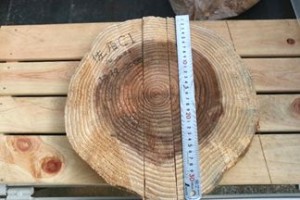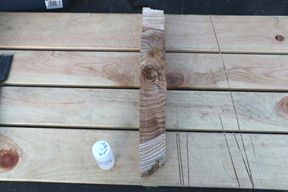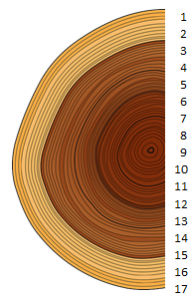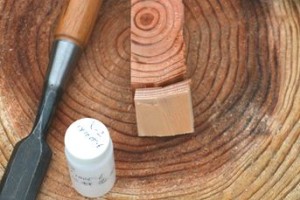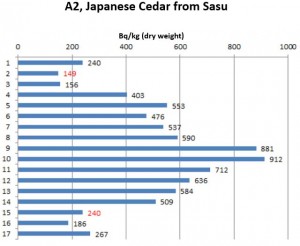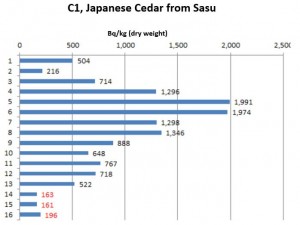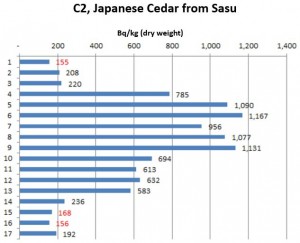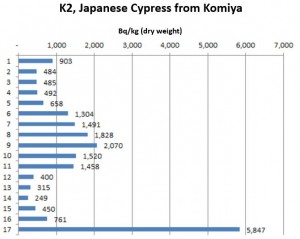Radiocesium concentrations inside the trunks of Japanese cedar and Japanese cypress
Reported by Osamu Uchida, Ichio Ii
Radiocesium was found to concentrate towards the center of the trunks of Japanese cedar and Japanese cypress, to a maximum of 2,000 Bq/kg according to the measurement of several samples taken from a small forest called Igune surrounding farm houses in Iitate.
Radioactive plumes flew down to many places in a wide scope including Iitate village right after the nuclear power plant accident and spread to the Japanese cedar and Japanese cypress trees. These trees were planted to form what is called an Igune which surrounds residential houses.
This resulted in contamination of the bark and leaves of these trees which became a source of radiation, thereby providing impact of ambient dosage around the residential houses.
This phenomenon has already been known but it was not made aware that it has been working its way through the tree trunks since little measurement was done to check the extent of the radioactive matter which has seeped through the tree trunks. Because it was not that easy to cut the trees of the Igune surrounding the residential areas just for measurement purposes.
The situation has changed recently when some of the trees were cut as part of the decontamination work being done. We were then able to obtain some trunk samples from the felled trees and measured the radiocesium level inside the trunks.
First, we carved a disc from a trunk. Then we cut a block going through the diameter at the center of the disc. Further, we cut the block equally to 16-17 pieces and packed each piece into individual vials for radioactivity measurement.
The cross section drawing on the left illustrates the location numbers of sample pieces that were used in the following charts.
Sample A2 was taken from a felled Japanese cedar tree at 150 cm above the tree stump, which had stood in an Igune behind a residential house in Sasu district.
The numbers on the vertical axis indicate the approximate/relative positions in the trunk as shown in the previous chart. Each bar length and number shows radioactivity at the location in Bq/kg (dry weight). A red color indicates that radioactivity at the location was less than the detection limit and the red number itself indicates the value of the detection limit.
C1 was taken from another felled Japanese cedar tree in the same Igune as that of A2. The sample was cut out at 20 cm above the tree stump
C2 was taken from the same tree as C1, and the sample was cut out at 150 cm above from C1.
K2 was taken from a Japanese cypress in Komiya district. No. 17 in the chart is the bark.
All the samples except the outmost part indicate that radiocesium seems to concentrate toward the center inside the trunk, to a maximum 2,000 Bq/kg. We will study further by sharing with forest experts whether this tendency depends on the tree species and the way radiocesium transfers toward the center.
